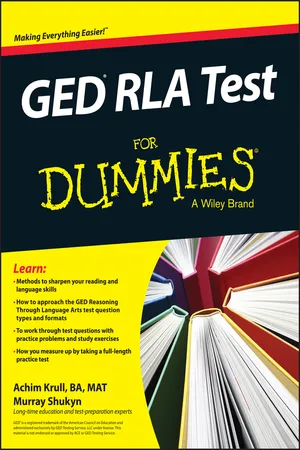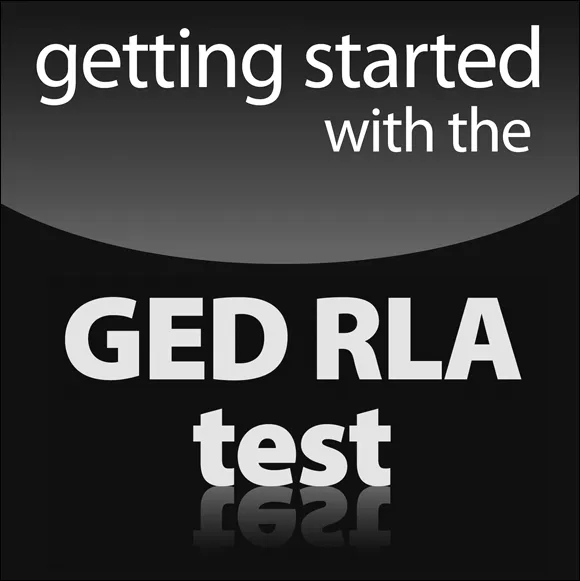
- English
- ePUB (mobile friendly)
- Available on iOS & Android
GED RLA For Dummies
About This Book
Read and write your way to excellence on the GED RLA Test
Does the thought of taking the GED RLA Test make you red in the face? Fear not! With the help of GED RLA Test For Dummies, you'll get up to speed on the new structure and computer-based format of the GED and gain the confidence and know-how to pass the RLA Test like a pro. Packed with helpful guidance and instruction, this hands-on test-prep guide covers the concepts covered onthe GED RLA Test and gives you ample practice opportunities to assess your understanding of the Language Arts, Writing, and Language Arts Reading sections of the exam.
Designed to test your understanding of reading, writing, and editing skills, the GED RLA Test can be tough for the uninitiated. Luckily, this fun and accessible guide breaks down each section of the exam into easily digestible parts, making everything you'll encounter on exam day feel like a breeze! Inside, you'll find methods to sharpen your reading and language arts test skills, tips on how to approach GED RLA question types and formats, practice questions and study exercises, and a full-length practice test to help you pinpoint where you need more study help.
- Presents reviews of the GED RLA test question types and basic computer skills
- Offers passages and questions that assess reading comprehension, language conventions, and usage
- Includes one full-length GED RLA practice test
- Provides scoring guidelines and detailed answer explanations
Even if reading, writing, and editing have never been your strong suit, GED RLA Test For Dummies makes it easy to pass this crucial exam and obtain your hard-earned graduate equivalency diploma.
Frequently asked questions
Information
Getting Started with the GED RLA Test





Taking a Quick Glance at the GED RLA Test





Knowing What to Expect: The GED Test Format
www.gedtestingservice.com within a day of completing the test. You can then send your transcript and diploma to an employer or college. Doing so allows employers and colleges access to a detailed outline of your scores, achievement, and demonstrated skills and abilities. This outline is also a useful tool for you to review your progress. It highlights those areas where you did well and areas where you need further work. If you want to (or have to) retake the test, these results will provide a detailed guide to what you should work on to improve your scores. Requests for additional copies of transcripts are handled online and also are available within a day.Reviewing the GED RLA Test
- The literacy component asks you to correct text, respond to writings, and generally demonstrate a critical understanding of various passages. This task includes demonstrating a command of proper grammar, punctuation, and spelling.
- The Extended Response item, also known as “the essay,” examines your skills in organizing your thoughts and writing clearly. Your response will be based on one or two source text selections, drawing key elements from that material to prepare your essay.The essay is evaluated both on your interpretation of the source texts and the quality of your writing. You type on the computer, using a tool that resembles a word processor. It has neither a spell-checker nor a grammar-checker. How well you use spelling and grammar as you write is also part of your evaluation. You’ll have an erasable tablet on which to prepare a draft before writing the final document.
- The scores from both components will be combined into one single score for the RLA test.
- Workplace materials: These documents include work-related letters, memos, and instructions that you may see on the job.
- U.S. founding documents and documents that present part of the Great American Conversation: These bits may include extracts from the Bill of Rights, the Constitution, and other historical documents. They also may include opinion pieces on relevant issues in American history and civics.
- Informational works: These texts include documents that present information (often dry and boring information), such as the instructional manual that tells you how to set up an Internet connection on your tablet. They also include materials that you may find in history, social studies, or science books.
- Literature: These sources include extracts from novels, plays, and similar materials.
Table of contents
- Cover
- Title Page
- Table of Contents
- Introduction
- Part I: Getting Started with the GED RLA Test
- Part II: Enhancing Your RLA Skills
- Part III: Putting Your RLA Knowledge and Skills to the Test
- Part IV: The Part of Tens
- About the Authors
- Cheat Sheet
- Advertisement Page
- Connect with Dummies
- End User License Agreement


